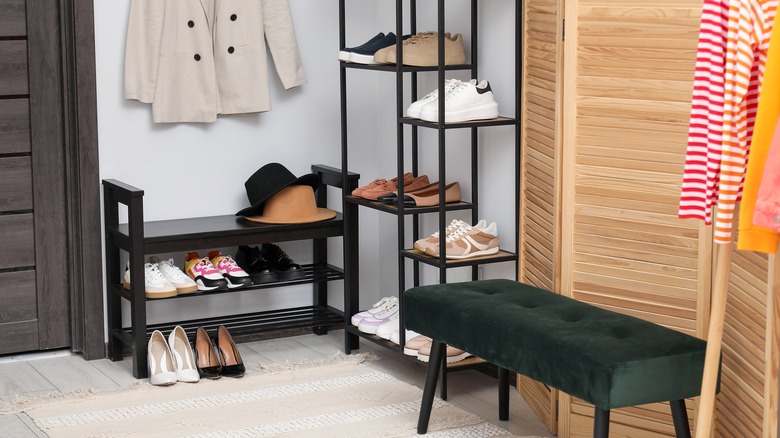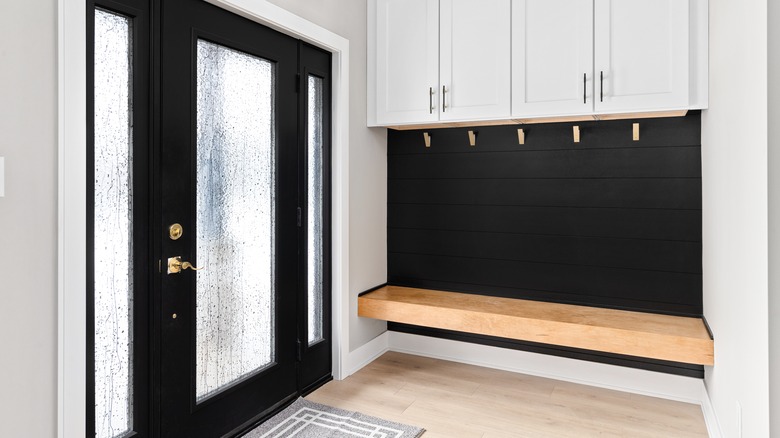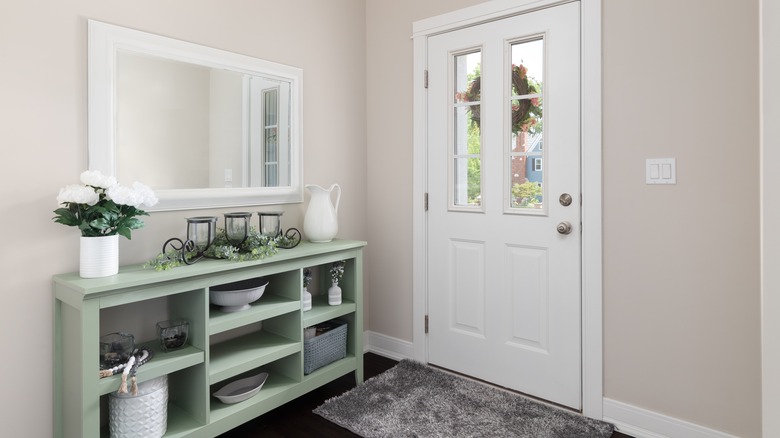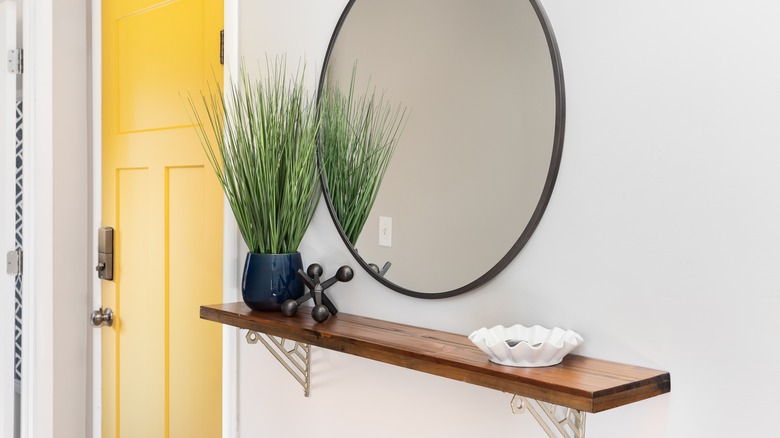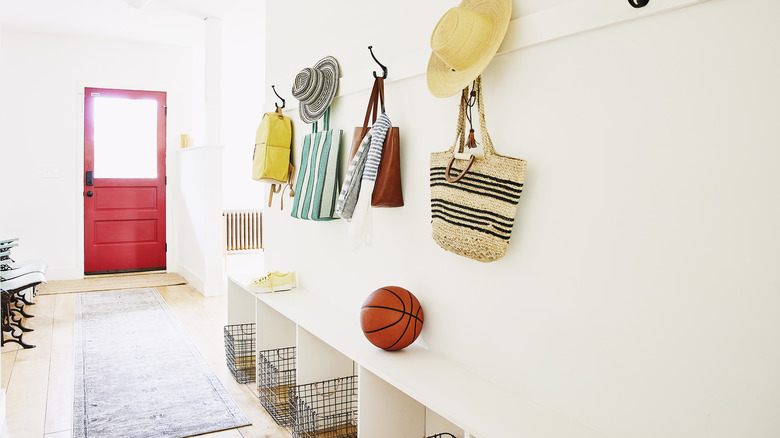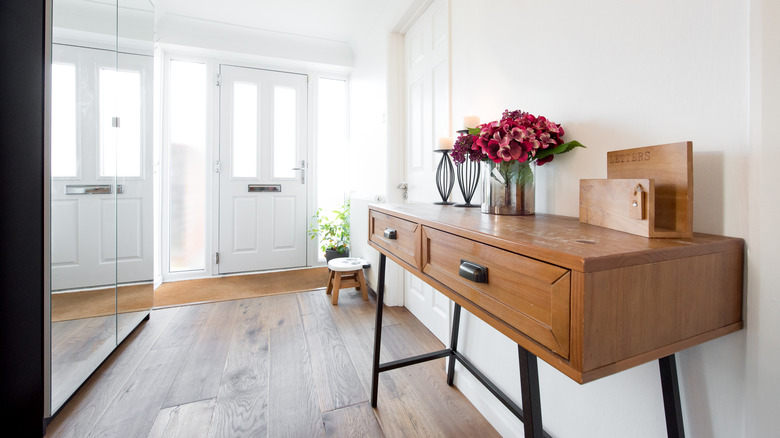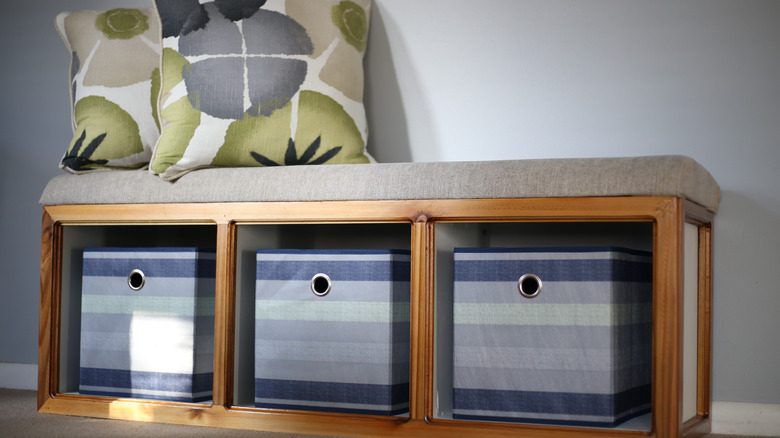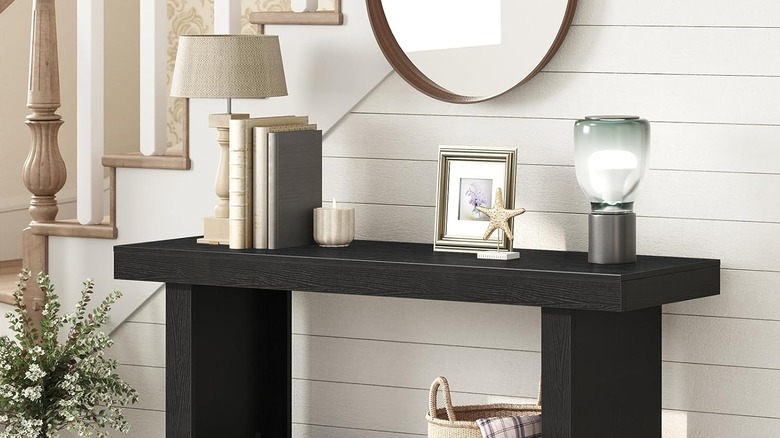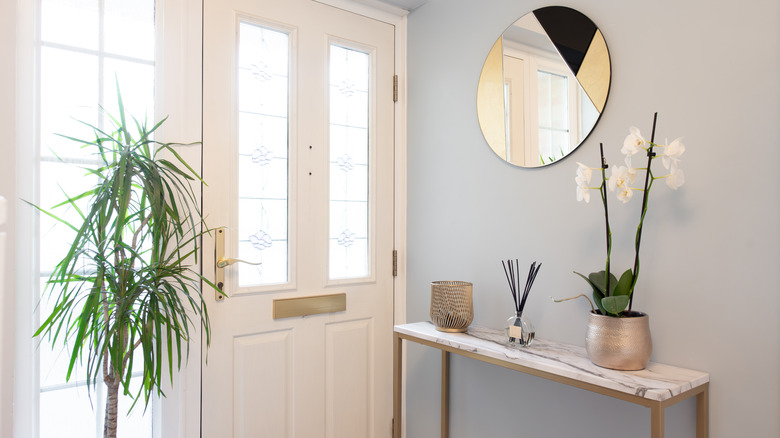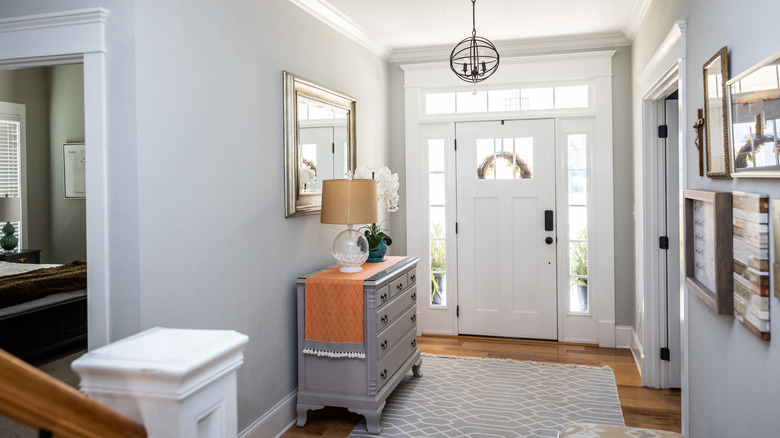Tips For Making Your Entryway More Functional
We may receive a commission on purchases made from links.
Your phone chimes with a "five minutes away" message from your guests, and you frantically dash around to hide your clutter in closets and bedrooms. After ensuring everything is spick and span, you make your way to the door and practice your best smile only for it to falter once you look at your entryway. The haphazardly arranged shoe mountain, teetering mail stack, and rack suffocated under coats will ruin your "oh, I'm totally organized" facade and set the wrong tone. However, it doesn't have to be this way. Thoughtful planning and strategic placement can do wonders for your home's entry.
By adding consoles, hidden storage, and multi-duty furniture, you can better organize your stuff. Creating specific drop-off zones for common items and utilizing vertical space can help, too. Better lighting and seating can further squeeze more functionality from your entryway. But before making any changes, take your lifestyle and personal preferences into account. Adding closed cabinets instead of open baskets when your kids are more likely to toss things around might not work out how you envision. Likewise, adding open shelves when you prefer stashing things out of sight may not be the best choice. The good news is you don't have to incorporate all of these elements into your space. Simply pick between two and five items to create adequate utility. Ready? Here's our roundup of practical tips to create a more functional entryway.
Outfit the foyer with seating
Whether you like rocking statement footwear or stick to comfy sneakers, you need a space to sit down and put on or remove your shoes. Adding seating helps with that, making your entryway more functional. Plus, you won't have to risk your spouse's icy glare for tracking in mud through the living room. Waiting for an Uber or a family member to get ready is also a little less frustrating if you can take a seat by the door.
All you have to do is find something that best fits your budget and entryway's dimensions. It could be as simple as a stool or small ottoman. Bonus points if it's artsy, like Cwuint's Bamboo Dining Stool, since injecting personality is as important as maintaining utility. If your entryway feels cramped, consider using acrylic furniture, such as Modway's Fully-Assembled Armchair. This design hack can visually declutter crowded rooms because clear chair lines don't add much visual weight. Plus, they're practical. If you find acrylic distasteful, check out upholstered chairs or a bench on raised legs. They'll keep the design open and you can sneak in an item or two underneath for temporary storage. Make sure to purchase fabrics with Martindale scores over 18,000, especially if you have children or pets. Where floor space is at a premium, consider investing in Flngr's Wall Mounted Teak Seats, and fold them up when in disuse.
Add an entryway table or console as a drop-off point
Don't you hate it when you walk into your home and have nowhere to place the groceries, dog treats, and mail hogging your arm space? Position a table in the center of your entryway to create a quick drop-off zone. This can work wonders in larger entryways, giving you tons of space to place things down, while also grounding the area and functioning as a visual anchor.
In narrow entryways, switch out round tables for a skinny console pushed against the wall. It could be something as slender as Mahancris' 3-Tier Industrial Console Table that looks snug in small spaces. Or, you could try Luviohome's Mid-Century Design that's more stylish with closed drawers. You can even make a stunning modern entryway table with IKEA salad bowls or explore nesting tables. Remember to leave a sufficient walking distance between the console and the door. Don't forget to use this opportunity to deck the table with a few sentimental pieces or plants so that your space is as pleasing as it is functional.
Set up dedicated zones and solutions for grab-and-go items
If your entryway looks cluttered even with a nice-looking console, chances are it's collecting oddball items. Think car keys, sunglasses, wallets, umbrellas, or spare spectacles. Intuitively, keeping them on the table makes sense. You can just grab them and head out. However, things get tricky in the return stage. Random items, such as sanitizer wipes, bug repellents, and even costume jewelry, invariably find their way here. And they keep collecting dust, adding to your entryway's visual mess. To rectify this, use Jeremiah Brent's sleek entryway storage idea to keep essentials tucked away in style and place a gorgeous, catch-all bowl on your console table or seating.
Additionally, if you find yourself constantly rummaging through the bowl and coming up short, you should look into creating dedicated solutions for separate items. For instance, small pieces could go in a shallow dish, such as this Beunaizer Jewelry Dish. Slightly larger items like sunscreen can be squirreled away on a multi-purpose organizer, like Shinpuru's Key Tray With a 3-Tier Hanging Organizer. For wet items, keep a dedicated stand tucked behind your door. Mango Steam's Pluvian Soakstone Umbrella Holder is a good option. You may also want to stash away canes, walking sticks, or rolled up workout mats into a vertical stand.
Utilize vertical space in narrow entryways
In case you've left the entryway walls (and the back of the front door) unadorned because it's a "transitional area anyway," perhaps you should rethink your decision. In small spaces or narrow walkways, utilizing vertical areas for storage is key to making entryways more functional. Plus, it can be super fun.
Rather than putting up a staid hooked rail on the wall, use sturdy, statement hooks that add visual interest while also fulfilling their functional role. Indian Shelf's Heavy Duty Crystal Hooks are an excellent option if you're looking for a quirky eclectic vibe. Or to showcase your nature-loving side, invest in holders that depict natural elements, like Lcyolada's Dragonfly Hooks. Rather than lining up the hooks straight, consider arranging them randomly at different heights. This will add visual interest and make it difficult for kids and pets to access organizers that aren't meant for them.
Another option is to suspend sturdy baskets, like Sansheng's Hanging Storage Bags, from the fasteners and conveniently toss in mittens, shoes, or mail. To keep things organized, label the bags according to categories or family members. For bulkier items like bicycle helmets and sports equipment that needs to live by the door, you may want to introduce floating shelves and bins instead. Built-in cabinets could work, too, but ensure they're only about 12 inches deep in a tight entry. If your entryway organization needs feel like they're always in flux, consider installing a pegboard on one wall that you can easily reconfigure to accommodate different items.
Enhance hidden storage so you don't have to grapple with haphazardly strewn shoes
Does your biggest nightmare involve guests tripping over shoes as they step inside the foyer? Or, is it them scrunching their noses against the accompanying stink? Put your worries to rest with hidden storage. Fortunately, it doesn't have to be anything fancy (although feel free to go all out if your budget allows). The important thing is to be intentional with your purchases.
For instance, if you are investing in a side table, choose the one with deep drawers. This way, you can store things like bulky boots out of sight. Or, if you want a bench for seating, grab the type with a hinged top, such as the HomePop Large Decorative Storage Bench, to quickly chuck your sweaty sneakers into it. Even better, if space allows, squeeze in a shoe cabinet that pops open, revealing multiple rows for stowing away your kicks. Maupvit's Shoe Storage Cabinet With 2 Flip Drawers is a worthy choice. Plus, the flat tabletop will help the piece double as a drop-off zone. Whatever your pick, make sure you leave at least a 2-foot walkway to avoid disrupting foot or stroller traffic.
Incorporate multipurpose furniture to maximize space utilization
To upgrade your foyer's functionality without sacrificing premium real estate, deploy multi-purpose furnishings strategically around the area wherever possible. That way, you could put the same item to multiple uses without wasting any more space. For instance, your seating could include cubbies for cube bins that you may use as seasonal storage. Or, instead of opting for a basic ottoman, choose one that has inbuilt storage, like the Wimarsbon's Round Ottoman. Similarly, if you enjoy hosting friends but find yourself scrambling to seat their last-minute invites, get clever multi-purpose furniture pieces like the Lugshiree 5-in-1 Nesting Ottoman Cube Chair. On its own, you could use it as a stool, and pull it apart when you need more seats in the living area.
If your entryway is furnished already with floating shelves, enhance their usefulness by fastening hooks underneath instead of installing a separate coat rack. Keep things organized by mounting a shadow box, like this Ikee Design Wall Mounted Wooden Collectible Shadow Box, and adhering a print to the glass, so you have a decor piece that doubles as storage for small objects. Alternatively, the Butizone Shadow Box Frame offers an easy way to display memorabilia, art, or pictures and incorporates a small drawer to house your keys, wallet, or other to-go items. You could also turn it into a command center, nailing any important mail you need to get through shortly. All-in-one solutions, such as hall trees that include pegs, hooks, and shelves, can also be highly practical.
Include additional light features to improve visibility
Entryways often get minimal lighting, and many people don't think to add any extra. After all, you probably don't linger there for long and can navigate the area using natural light during the day and a ceiling light or two after dusk. But by sprinkling in more light sources through things like sconces, you can improve both your entryway's visual appeal and its practicality.
To start, if you're not ready to call in an electrician to hardwire in additional lights, consider rechargeable options like puck lights. By peppering your hallway with a few well-placed puck lights (they can be tucked under shelves or inside potted plants for mood lighting and task lighting) or even some battery-operated LED candles, you can easily create the desired atmosphere. Homemory's Flickering Flameless Candles are a good choice and allow you to adjust the duration they remain on with a remote. Other unique ways to make your home's foyer stand out which also don't involve hardwiring in lights include adding a couple of table lamps to your console or using plug-in sconces on the walls (one on each side of the mirror is usually the most practical if you're wondering about placement). To further improve practicality, fit your entryway cabinets or mudroom closets with motion sensor lights, such as these rechargeable Auxoda Wireless Indoor Lights. That way, digging around for your AirPods and loose change will be easy as you head out the door.
Hang a mirror at eye-level
Functionality isn't restricted to keeping your entryway clutter-free. It's also about making the space working for you, such as by placing a mirror in your entryway. Aside from helping you conduct the "just-in-case" last-minute check, it'll brighten the area by reflecting light around the room. This will improve visibility and make the area seem larger.
However, not any mirror would do — make it a statement piece to improve your entryway's aesthetics. But even more importantly, look for one sporting hooks or pegs underneath where you can conveniently sling your bags, jackets, or chargers, or one with a built-in shelf at the bottom. Another option is to choose mirrors with hidden storage, such as Royal Windsor's Mirror Wall Cabinet With Storage and Shelf. Be cognizant of the mounting height, making sure it's at eye level. If you're suspending your mirror over the console and the mounting height leaves plenty of gap between the two, incorporate taller décor items, like plants or a sculptural vase, to keep things visually proportional. Where budget and space aren't substantial constraints, opt for a full-length mirror to make a stylish, yet functional, statement. If you're not sure how big to go, use these tips on how to choose the best size for an entryway mirror.
Protect your floor and trap tracked-in dirt with a runner or rug
Lastly, ground your entryway with a rug or a runner. Not only will it prevent slip hazards, but it'll also catch the dirt and mud that your front door mat didn't absorb. It'll even help reduce the daily wear and tear your bare floors will otherwise be forced to take — and let's face it, replacing them is far more expensive than a rug. It'll also keep things cushy during the cold winter months, while absorbing sound. If your entryway floor has already taken a bit of a beating and sustained scratches or water damage, a well-placed rug could help mask these unsightly scars. From a space planning perspective, a rug will also define the area and demarcate it from other rooms.
But to enjoy these benefits, you must choose your rug wisely. Look for options that have a dense, high pile for a cozy feeling and avoid flimsy pieces, like thin cotton rugs that crumple and get mussed every time someone walks over them. Also, factor in scale — don't use a small mat in a narrow hallway when a runner would work better. Dark hues are typically better at masking dirt, so you may want to go with a moody color. To reduce maintenance, pick a runner whose fibers are easy to clean, such as cotton, or even go for an indoor/outdoor option which you can literally hose down outside when it starts getting a little grimy.
